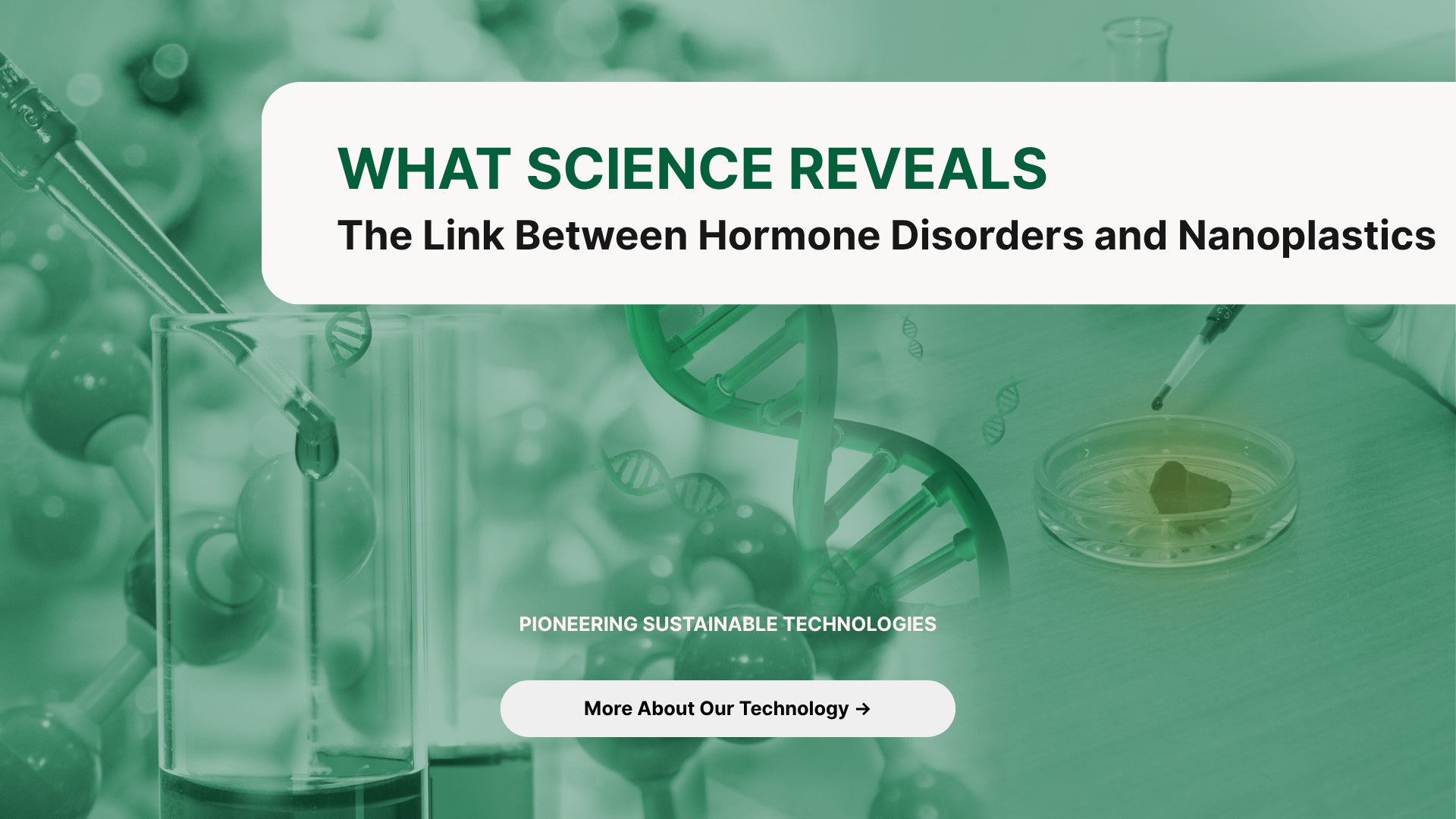Over the past decade, researchers have warned that microplastics are not just an environmental crisis, they are a biological one. But 2024 marked a turning point. A new wave of peer-reviewed studies has revealed a direct and disturbing link between nanoplastics and hormone disorders in humans, affecting everything from fertility to neurological development.
These microscopic invaders, often invisible to standard filtration or diagnostic tools, are now found in human blood, placenta, testes, and breast tissue. But more than mere presence, nanoplastics appear to act as endocrine disruptors, synthetic substances that interfere with hormone regulation in the body.
This blog explores what we now know about nanoplastics and hormone health, what the science reveals about long-term risks, and why urgent action on packaging, especially HDPE and LDPE reform, is central to preventing a slow-motion public health emergency.
Understanding the Endocrine System
The endocrine system regulates hormones, chemical messengers that control metabolism, growth, reproduction, sleep, and stress. These hormones are produced by glands like the thyroid, pituitary, and adrenal, and are especially critical during periods of physical and neurological development.
Disruption to this system can lead to:
• Fertility problems in men and women
• Thyroid dysfunction
• Early puberty or delayed growth in children
• Hormone-sensitive cancers (breast, prostate, ovarian)
• Metabolic disorders like obesity and insulin resistance
Endocrine disruptors, or EDCs, are substances that mimic, block, or alter hormone signalling. Many are synthetic chemicals used in plastics, pesticides, and industrial solvents.
What Are Nanoplastics Doing in the Body?
Nanoplastics are particles smaller than 1 micrometre, derived from the breakdown of larger plastics or intentionally engineered in consumer products. Their size allows them to penetrate biological barriers including the blood-brain barrier and placental wall.
Once inside the body, nanoplastics may:
• Bind to hormone receptors and interfere with normal function
• Trigger chronic inflammation in endocrine tissues
• Alter DNA expression through epigenetic mechanisms
• Accumulate in hormone-rich organs such as ovaries and testes
Studies using advanced spectrometry and imaging now confirm these particles not only circulate in the bloodstream, but can embed themselves in tissue and persist for extended periods, amplifying their impact over time.
Landmark Studies and Evidence
In 2023, researchers at the National Institute of Environmental Health Sciences (NIEHS) conducted a controlled mouse study where nanoplastics were introduced via drinking water at levels similar to those found in bottled water and seafood. The results were stark:
• Female mice showed altered oestrous cycles, reduced egg quality, and delayed ovulation
• Male mice exhibited lowered testosterone and reduced sperm count
• Gene expression in the hypothalamus, a key hormone-regulating brain region, was disrupted
Meanwhile, in a human observational study published in The Lancet Planetary Health (Feb 2024), urine samples from 1,200 individuals across 12 countries showed strong correlation between nanoplastic levels and abnormal hormone profiles, including elevated oestrogen in men and suppressed progesterone in women.
HDPE and LDPE: Ubiquitous and Under-Scrutinised
HDPE and LDPE plastics are used in packaging for food, cosmetics, bottled water, and personal care. While classified as “safe” by regulatory agencies, they are still prone to micro and nanoplastic shedding, particularly when exposed to heat, UV light, or mechanical stress.
In 2024, scientists at Columbia University revealed that single-use plastic bottles made of PET and HDPE released an average of 240,000 particles per litre, the majority of which were small enough to be classified as nanoplastics.
For children, exposure begins early, from baby bottles and sippy cups to snack pouches and plastic toys. This means the endocrine system is being disrupted during the most vulnerable developmental stages.
Health Impacts in Children and Teens
The endocrine system governs key transitions in early life, puberty, brain maturation, metabolic programming. Disrupting it with plastic-derived EDCs may lead to:
• Earlier onset of puberty in girls (linked to elevated BPA and phthalates, often present in plastics)
• Disrupted testosterone levels in boys, impacting muscle and bone development
• Higher risk of attention deficit and behavioural disorders
• Reduced IQ and cognitive flexibility (per multiple European cohort studies)
These impacts may not manifest immediately but accumulate over time, with long-term consequences for fertility, neurological health, and chronic disease risk.
Hormone-Related Cancers and Plastics
Nanoplastics have now been implicated in the pathogenesis of hormone-sensitive cancers.
A 2024 meta-review in Nature Reviews Endocrinology found consistent evidence that EDC exposure increases risk for:
• Breast cancer in women under 45
• Testicular cancer in men under 40
• Thyroid cancer in high-exposure occupations
• Uterine fibroids and polycystic ovary syndrome (PCOS)
Nanoplastics act as pseudo-oestrogens, molecules that bind to oestrogen receptors and mimic the hormone, even in the absence of natural triggers. This can fuel unchecked cell proliferation and tumour growth.
Why Packaging Reform Is a Health Priority
While microplastics in marine life captured public imagination, it is nanoplastics in consumer packaging that represent the greater human health threat. Bottled water, packaged meals, cosmetics, and processed foods are the main exposure vectors, not beaches.
The solution lies in a shift to certified biodegradable alternatives, materials that do not fragment into micro or nano waste, such as those using depolymerisation technology.
Eco Bottles, for instance, degrade fully in landfill, leaving no traceable plastic residue. This removes the root cause of ingestion via bottled water, which remains one of the most frequent sources of daily nanoplastic intake.
Regulating Plastics Through the Hormonal Lens
Few regulatory frameworks explicitly treat nanoplastics as hormonal disruptors, a critical blind spot in public health policy.
Some positive steps are emerging:
• The EU Chemicals Strategy for Sustainability has named EDCs as “substances of very high concern”
• Canada is piloting hormone disruption testing in product safety protocols
• California’s SB-1049 bill includes nanoplastics as part of endocrine disruptor regulation in drinking water
Still, these policies are early-stage and fragmented. There is no global consensus or standard for nanoplastic regulation in the context of endocrine health, despite overwhelming scientific momentum.
Corporate Responsibility: The Cost of Inaction
Brands that market to children, families, and women must now recognise hormone disruption as a material ESG risk. Continued use of non-certified plastics in packaging could soon result in:
• Regulatory penalties in export markets like the EU
• Reduced access to green bonds and ESG finance
• Class-action lawsuits tied to hormone-related illness clusters
• Reputational damage as consumer awareness increases
On the other hand, early adoption of microplastic-free packaging may lead to competitive advantages, including “clean hormone” certification potential in wellness markets.
Conclusion: A Hidden Crisis Comes to Light
Nanoplastics are no longer invisible. They are measurable, present in the human body, and implicated in one of the most delicate systems we have, the endocrine system.
From early puberty to declining fertility and rising hormone-related cancers, the evidence now points to a widespread, slow-burning crisis with roots in everyday plastic exposure.
The solution is not just better recycling or clean-up campaigns. It is a fundamental shift in material science and consumer product design, one that must prioritise biodegradability, non-toxicity, and hormonal neutrality.
We cannot afford to wait for further proof. The science is clear enough to act. And the next generation is already at risk.
Key Summary
✓ Nanoplastics are confirmed endocrine disruptors found in blood, placenta, and hormone-regulating organs
✓ Exposure is linked to fertility decline, early puberty, thyroid disorders, and hormone-related cancers
✓ HDPE and LDPE plastics in bottles and packaging are major sources of nanoplastic shedding
✓ Certified biodegradable packaging can eliminate this exposure at the source
✓ Policy frameworks are beginning to acknowledge EDCs, but stronger global standards are urgently needed
✓ Brands must shift now to avoid health risks, regulatory fallout, and ESG penalties
References
- NATIONAL INSTITUTE OF ENVIRONMENTAL HEALTH SCIENCES. Nanoplastics and endocrine disruption in mammalian models. NIEHS Research Brief, 2024. Available at: https://www.niehs.nih.gov
- THE LANCET PLANETARY HEALTH. Global assessment of nanoplastic exposure and hormonal biomarkers. Vol. 8, Issue 2, Feb. 2024. Available at: https://www.thelancet.com
- COLUMBIA UNIVERSITY NANOPLASTICS RESEARCH GROUP. Quantifying nanoplastics in bottled water. Science Advances, 2024. https://www.science.org
- NATURE REVIEWS ENDOCRINOLOGY. Environmental exposure to endocrine disruptors and hormone-related cancer risk: a global meta-analysis. Jan. 2024.
- EUROPEAN COMMISSION. Chemicals Strategy for Sustainability – Towards a toxic-free environment. Brussels, 2023. https://ec.europa.eu

